Black gum (
Nyssa sylvatica) is a slow-growing, medium to large tree native to mostly moist habitats in the eastern U.S. Many people are aware of black gum, also called tupelo, because of the song
Tupelo Honey. This honey, renowned for its delicate flavor, is made by bees that frequent black gums in the spring. From the landscape point of view, the tree is noted for its lustrous summer foliage, reliably intense red fall color and upright form with strong horizontal branching.
Although black gums take many years to reach maturity, young trees can be enjoyed for their color and excellent form. By planting them, you’ll provide a legacy for future generations. Also, long-lived trees like black gum are useful as storehouses for atmospheric carbon, both aboveground in its large trunk and limbs, and underground in its deep root system.
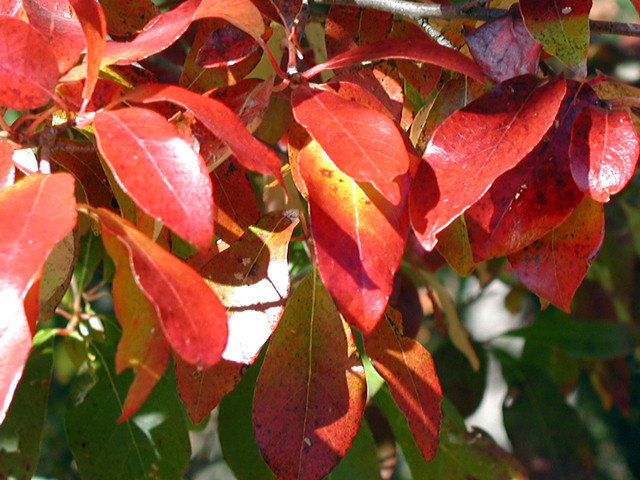 Botanical names: Nyssa sylvaticaCommon names:
Botanical names: Nyssa sylvaticaCommon names: Black gum, blackgum, tupelo, black tupelo, sour gum, pepperidge
Origin: Native from southern Maine to central Florida in the east and as far west as Michigan and eastern Texas
Where it will grow: Hardy to minus 30 degrees Fahrenheit, or minus 34 degrees Celsius (USDA zone 4 to 9; find your zone)
Typical plant communities: Grows in a variety of habitats, from drier upland fields and slopes to wet woodlands, pond edges and stream banks; best in slightly acidic soils, pH 5.5 to 6.5; doesn’t tolerate alkaline conditions
Shown: Black gum’s intense red fall foliage is its most distinctive characteristic.
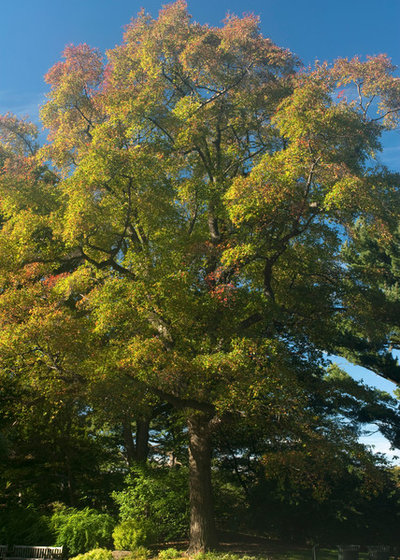
The New York Botanical Garden
Water requirement: Reaches its maximum size in moist soils; grows more slowly and to a smaller size under drier conditions
Light requirement: Prefers full sun but will tolerate some shade; grows slowly under shaded conditions and puts on rapid growth when shade is removed
Mature size: Typically reaches 30 to 50 feet tall (80 feet under ideal conditions) and 20 to 30 feet wide; tends to be smaller in northern range; slow growth rate can be sped up slightly with consistent moisture and a little fertilization
Benefits and tolerances: Handles soils with low levels of oxygen, such as clay and areas surrounded by pavement; has some resistance to de-icing salts, making it a good candidate for use near roads and parking lots; tolerates wet soils and periods of flooding
Shown: This mature specimen at the The New York Botanical Garden shows what to expect after 50 to 100 years.
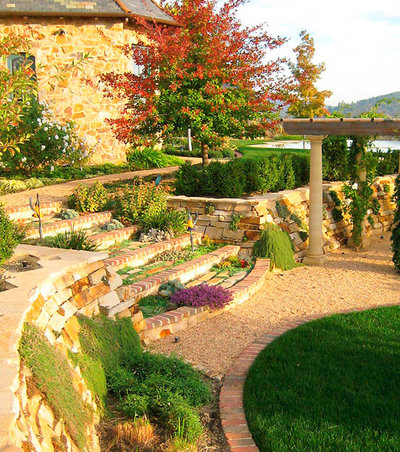
Wu-Way Landscape
Seasonal interest: Black gum blooms in midspring as the leaves are unfolding. The flowers are not showy but are extremely attractive to honeybees. In summer, the shiny, large dark green leaves give the tree a lustrous appearance. In early fall, the fruit ripens as dark blue drupes. Though sour, these are attractive to a wide variety of birds. Black gum has excellent fall color. In early fall, it turns an intense red, with accents from orange to purple.
When to plant: Container-grown plants can be planted spring or fall. Balled-and-burlapped plants should be planted only in early spring. New plants should be watered well until established.
Shown: This black gum is just beginning to turn color; note the pyramidal form and horizontal branching typical of a young tree.
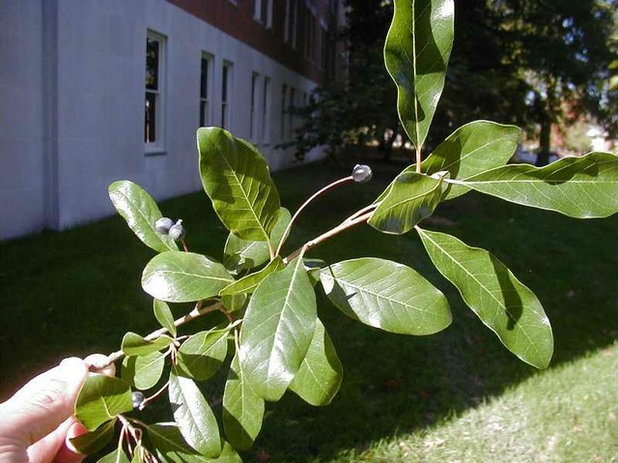 Distinguishing traits.
Distinguishing traits. Young trees have a pyramidal form with predominantly horizontal branching. They maintain a strong central leader as they age. Mature trees often take on a more rounded form but are generally upright, growing about two-thirds as wide as they are tall. Black gum grows slowly, adding 6 to 12 inches in height per year.
The dark green leaves are elliptic to obovate and 3 to 5 inches long with a waxy surface that makes them reflective, giving the foliage a lustrous appearance. Foliage forms a dense canopy.
In most cases, male and female flowers are carried on separate plants. In order to get pollination and fruiting, male and female trees need to be planted close enough, about 100 feet, so that honeybees can easily transfer pollen from one to the next.
Although you won’t see it, black gum has a very deep taproot. This helps it endure challenging growing conditions but also makes transplanting very difficult.
Shown: This branch from a female tree shows the typical leaf shape and (if you look closely) the dark blue fruit.
 How to use it.
How to use it. Since the tree is difficult to move, you should consider its mature size when planting. Its strong central leader and upright form make it a good candidate for a formal planting.
The horizontal branching is very strong. The lower branches can be left on the tree, visually anchoring it to the ground, or pruned to create a shaded space below. Since the leaf canopy is dense but late in developing, spring ephemerals are a good choice to plant underneath.
Its tolerance for wet or low-oxygen soils makes black gum a good choice for soggy sites or where the soil is compacted and not well-aerated.
Since the red fall foliage is its most outstanding feature, growing it with evergreens or other trees and shrubs with less vivid color will highlight its intensity.

Kerry Lewis Landscape Architects
Planting notes. When selecting container-grown trees, avoid ones that have a lot of circling roots. With balled-and-burlapped plants, look for ones whose trunks near the ground are less than 2 inches in diameter (2-inch caliper) for best success; plant them in early spring.
Black gum requires little maintenance. Pruning isn’t generally needed along the straight trunk, though it’s beneficial to remove crossing or damaged branches. While black gums do well under adverse soil conditions, they actually have trouble competing with other trees and shrubs in open, well-drained soils. Established plants have a deep taproot and can tolerate periods of drought.
Although the tree isn’t a deer favorite, I’ve noticed some browsing on branch tips in the winter. For my situation, a chicken-wire fence works well to protect the young plants.
Shown: The two trees shown here are located well away from the house to avoid problems as they reach full size.
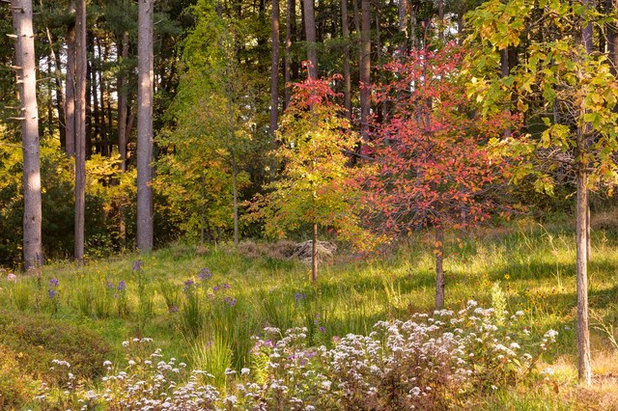
Kerry Lewis Landscape Architects
Black gums are available at many nurseries. The gender of young, wild-type plants can’t be determined until they begin to produce flowers. If fruit generation is important and no wild population is nearby, you should consider putting in three or more plants to improve the odds of having at least one of each gender.
Several cultivars have been selected for their desirable traits. If fruiting is important, one option to take out the guesswork is to buy known male and female cultivars. Unfortunately, a list of the gender of each cultivar isn’t universally available.
Some available cultivars:
- ‘Autumn Cascade’ is a male weeping form originally discovered as a seedling in a nursery in Australia and reintroduced to the U.S. by Dick Jaynes of Broken Arrow Nursery.
- ‘Carolyn’ is a female from Wisconsin with excellent cold hardiness.
- ‘Haymanred’ (aka Red Rage) is a male from southern Indiana with improved resistance to leaf spot and excellent red-orange fall color.
- ‘Miss Scarlet’ is a female plant from Missouri with brilliant red fall color.
- ‘Wildfire’ is a male with red-tinged new foliage that carries into summer; fall color is more golden than red; it was discovered as a seedling in an Oregon nursery. It is listed as hardy to minus 20 degrees Fahrenheit, or minus 29 degrees Celsius (zone 5), and seems to be on more nurseries’ availability lists.
- ‘Zydeco Twist’ is a male from Louisiana with zigzagging branches that show well in winter.
Swamp tupelo (
Nyssa biflora) is a good choice for sites with consistently wet soils.
Water tupelo (
N. aquatica) is a taller species native to the Southeast that grows well in standing water.
When selecting cultivars of a plant that has a large geographical range, and that covers a wide range of hardiness zones, it’s a good idea to confirm whether that specific cultivar will really be hardy in your zone. With black gum, this is particularly an issue for zones 5 and colder.
Shown: This
specimen with red-orange foliage grows in a rain gully, an excellent location for black gum.
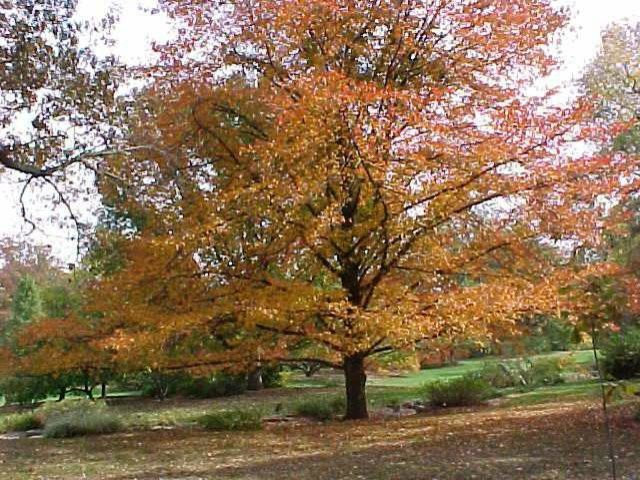 Pollinator notes.
Pollinator notes. In addition to being a bee tree in the spring, where a colony of bees may live, the tree’s leaves play host to several species of native caterpillars. Mature trees form cavities that provide nesting sites for many species of birds and some small mammals. The fruit that ripens in early fall is consumed by both migratory and nonmigratory birds.
Here, you can see how the strong horizontal branching of this mature tree holds the lower limbs off the ground.





